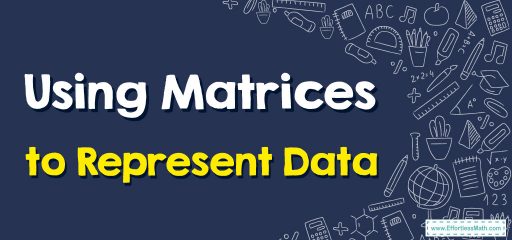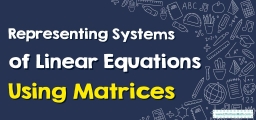How to Use Matrices to Represent Data
A matrix is a rectangular array of numbers, symbols, or expressions, arranged in rows and columns. Matrices can be used to represent and organize data in a compact and efficient way. Here are some examples of how to use matrices to represent data.

Related Topics
- How to Add and Subtract Matrices
- Transformation Using Matrices
- How to Find Inverses of \(2×2\) Matrices
- How to Solve a System of Equations Using Matrices
Step-by-step to Use Matrices to Represent Data
To find out how to use matrices to represent data, follow the step-by-step guide below:
1. Representing a system of equations: A system of linear equations can be represented as a matrix equation of the form \(AX = B\), where \(A\) is the coefficient matrix, \(X\) is the variable matrix, and \(B\) is the constant matrix. For example, the system of equations \(2x + 3y = 6\) and \(4x + 6y = 12\) can be represented as the matrix equation:
\(\begin{bmatrix}2 & 3 \\4 & 6 \end{bmatrix}\)\(\begin{bmatrix}x \\y \end{bmatrix}\)\(=\begin{bmatrix}6\\12 \end{bmatrix}\)
2. Representing a set of data: A set of data can be represented as a matrix, where each row represents an observation and each column represents a variable. For example, a set of data on the height and weight of three individuals can be represented as the matrix:
| Height (cm) | Weight (kg) |
| \(170\) | \(70\) |
| \(175\) | \(75\) |
| \(180\) | \(80\) |
3. Representing a linear transformation: A linear transformation can be represented as a matrix transformation of the form \(Y = AX\), where \(A\) is the transformation matrix and \(X\) and \(Y\) are the input and output vectors. For example, a transformation that doubles the \(x\)-coordinate and triples the \(y\)-coordinate can be represented as the matrix:
\(\begin{bmatrix}2 & 0 \\0 & 3 \end{bmatrix}\)\(\begin{bmatrix}x \\y \end{bmatrix}\)
4. Representing a graph: A graph can be represented as an adjacency matrix, where each element in the matrix represents the presence or absence of an edge between two nodes.
Matrices are widely used in various fields such as statistics, physics, computer science, engineering, and many more, to represent and organize data in a compact and efficient way.
Related to This Article
More math articles
- Overview of the AFOQT Mathematics Test
- Your Coach’s Playbook: How to Understand Percent of Change
- How to Graph Inverse of the Tangent Function?
- 10 Most Common 8th Grade MCAS Math Questions
- Top 10 3rd Grade FSA Math Practice Questions
- The Ultimate 6th Grade PSSA Math Course (+FREE Worksheets)
- How to Use Area Models to Add Fractions with Like Denominators
- FREE ParaPro Math Practice Test
- Graph to Grid: How to Completing a Table Using Information from a Graph
- Geometry Puzzle – Challenge 65






















What people say about "How to Use Matrices to Represent Data - Effortless Math: We Help Students Learn to LOVE Mathematics"?
No one replied yet.